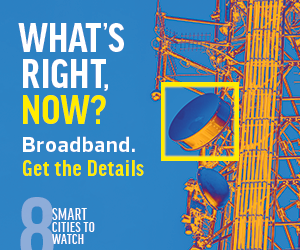The coronavirus pandemic has thrown into sharp relief the digital divide that exists in much of the United States. Many state and local governments have been working to close the divide by expanding access to broadband, including via the deployment of new municipal Wi-Fi services.
The evolution of the Wi-Fi standard will help make that mission easier, especially in cities, thanks to available improvements. Wi-Fi 6, compared with Wi-Fi 5, performs better in dense urban areas and delivers better data rates at a longer range, meaning that more people can have access to higher-speed broadband.
Wi-Fi 6 “excels in high-density local areas, making it ideal for a city’s public transportation centers, malls, stadiums, campuses, and so on,” Cisco Systems notes in a company blog post. “It’s relatively affordable to deploy, maintain and scale, and offers up to 4x the capacity of 4G networks.”
What is Wi-Fi 6, and how does it compare to Wi-Fi 5? What are the key advantages for cities and other local governments to deploying Wi-Fi 6 infrastructure?
RELATED: Follow these tips when building public Wi-Fi networks.
What Is Wi-Fi 6?
The technology advancement nonprofit IEEE certifies different Wi-Fi standards. The Wi-Fi 6 (802.11ax) standard is the successor to the IEEE’s 802.11ac standard, which the Wi-Fi Alliance retroactively labeled Wi-Fi 5.
802.11ac products hit the market in 2013. As a Cisco Meraki blog post from that year points out, at the time Wi-Fi offered many advantages over its predecessors, including the fact that “speed increases significantly for new clients that support 802.11ac.”
“Most of the first 802.11ac access points use triple-stream MIMO, similar to today’s top-end 802.11n access points, but will have a maximum data rate of up to 1.3 Gbps,” the post notes. “The increase comes from using 80 MHz channels and a new modulation scheme (256 QAM).”
Wi-Fi 5 also only works in the 5GHz spectrum band, as the blog post notes.
“Each new Wi-Fi number builds on the one before: Wi-Fi 6 (based on IEEE 802.11ax) focuses on environments such as corporate campuses and stadiums,” Joel Snyder, a senior partner with IT consulting firm Opus One, writes in StateTech. “Wi-Fi 5, the IEEE 802.11ac standard, is now widely deployed and should coexist well as Wi-Fi 6 debuts.”
Wi-Fi 5 vs. Wi-Fi 6: What’s the Difference?
Wi-Fi 6 builds on Wi-Fi 5, Netgear notes in a blog post. While Wi-Fi 5 “brought gigabit speeds” to our Wi-Fi connections, “it falls short on delivering the best” Wi-Fi experience due to more devices connecting to networks.
Wi-Fi 6 offers several differences and advantages over Wi-Fi 5. As Colin Vallance, a technical architect for CDW with a focus on wireless technologies, notes in a CDW blog post, “Wi-Fi 6 promises a multitude of exciting new features that are set to be the most radical changes to the 802.11 spec that we know and love.”
“The name of the game here is efficiency — the more efficient the radios are getting on and off the air, the more data can be moved, resulting in a better performing network,” Vallance adds.
Here are some of the key differences between Wi-Fi 5 and Wi-Fi 6:
- Orthogonal Frequency-Division Multiplexing Access: OFDMA is “probably the most critical new feature we’re getting in Wi-Fi 6,” Vallance writes, and it “works by slicing up the existing channel into smaller resource units (RUs), allowing multiple clients to be able to communicate with the access point simultaneously.”
OFDMA “enables your router and devices to use your bandwidth more efficiently by reducing the time between data transmissions,” Netgear notes in a blog post. “As a result, more bandwidth is available for other devices.”
OFDMA is “a type of frequency-division multiplexing that is able to use subcarriers more efficiently when it comes to transporting data. Previously, when using Orthogonal Frequency-Division Multiplexing (OFDM), each user got one time slot, or a whole bandwidth channel,” Cisco notes in a blog post on Wi-Fi 6.
Basically, Cisco says, “users needed to wait in line before they were able to deliver their packets. As more clients joined, it took longer for packets to be delivered, resulting in lag time and people waiting to transport data. OFDMA provides a more regular and consistent packet delivery, and users don’t have to wait as long.”
- Target Wait Time, or TWT gives clients the “ability to deterministically go to sleep for long periods of time, reducing power consumption and, in many devices, likely saving battery life,” Vallance writes. “The other added benefit of an access point being able to schedule TWT is that it can try to orchestrate times that do not overlap for clients on the same cell, reducing contention and freeing up the medium that much faster.” Cisco notes that as a result of TWT, “client devices that support the Wi-Fi 6 standard may consume two-thirds less power. This means that batteries in products such as smartphones, laptops, tablets, and IoT devices can last longer, which makes it the ideal standard.”
- Improved speed: Netgear notes that Wi-Fi 6 offers speed improvements over Wi-Fi 5. “Wi-Fi 6 enables devices to send more data in one transmission, resulting in speed improvements of up to 20%,” the firm says. Improvements through higher order modulation (1024-QAM) “increases the efficiency and speed of data transmission on your network. This technology can give up to 25% improvements in speed,” Netgear adds.
- Improved range: “20MHz-only devices and OFDMA’s ability to use smaller subcarriers means such devices can reach longer distances,” Netgear adds. Writing in TechTarget, Lee Badman, a network architect and wireless technical lead at Syracuse University, notes that Wi-Fi 6 “does bring more radio chains, better sensitivity and smaller channels in the form of resource units. These capabilities all contribute to the ability to achieve both increased usability and improved data rates farther out into the footprint provided by the same output power, which, in some cases, can feel like an increase in range.”
Benefits of Wi-Fi 6 for Smart Cities and Beyond
Wi-Fi 6 is not a panacea for a lack of broadband access, but its technological underpinnings and advantages do mean it can deliver faster and more pervasive wireless broadband coverage.
“Wi-Fi 6 enables significantly faster throughput in high density environments where many devices must use the same wireless access point,” Richard Jeffares, former CTO of broadband infrastructure firm Glide, writes in Smart Buildings Magazine. “Managed, pervasive Wi-Fi guarantees coverage over every inch of a residence whilst ensuring privacy and security. Wi-Fi 6 pervasive Wi-Fi will ensure faster, more robust connections across public spaces and campuses and create new guest experiences.”
Wi-Fi 6 is well suited to deliver connectivity in large venues, busy campuses and congested mass-transit hubs, IoT Business News reports. “Wi-Fi 6’s ability to also support high bandwidth and high user density but at a dramatically lower cost makes it ideal for indoor applications, such as stadiums, convention centers, shopping malls, school campuses and other places where people gather,” semiconductor firm NXP notes in a blog post.
Wi-Fi 6 upgrades can bring many benefits but should be undertaken in a deliberate manner by any city or agency. “A full Wi-Fi 6 deployment means changing access points, clients and infrastructure,” Snyder writes. “That’s a big step. Instead, IT managers should look for a gradual upgrade path, making sure anything added now can support Wi-Fi 6.”
MORE FROM STATETECH: Find out how smart cities may grow in the years ahead.













